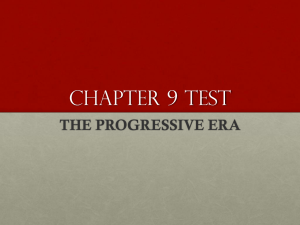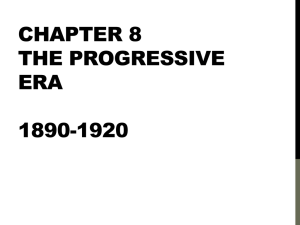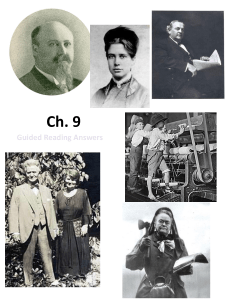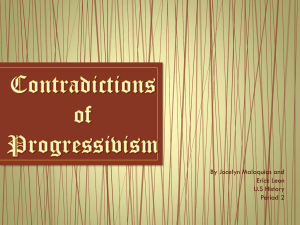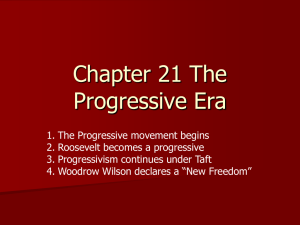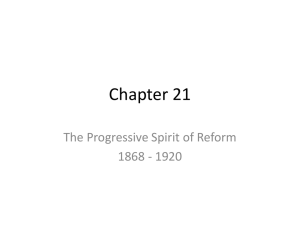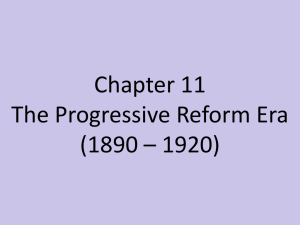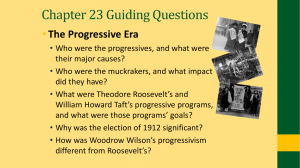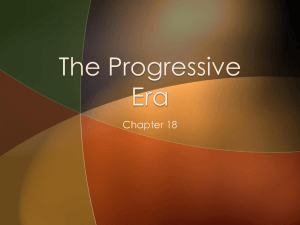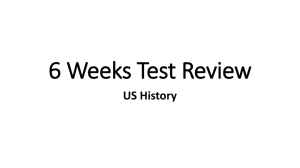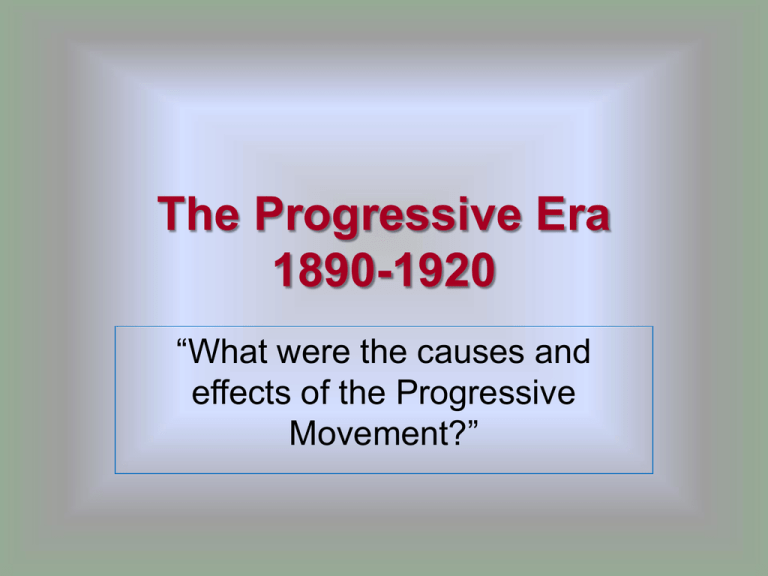
The Progressive Era
1890-1920
“What were the causes and
effects of the Progressive
Movement?”
• SSUSH13 The student will identify major efforts to
reform American society and politics in the
Progressive Era.
a. Explain Upton Sinclair's The Jungle and federal
oversight of the meat packing industry.
b. Identify Jane Addams and Hull House, and the
role of women in reform movements.
c. Describe the rise of Jim Crow, Plessy v. Ferguson,
and the emergence of the NAACP.
d. Explain Ida Tarbell's role as a muckraker.
e. Describe the significance of progressive reforms
such as the initiative, the recall, and referendum,
direct election of senators, reform of labor laws and
efforts to improve living conditions for the poor in
cities.
Read Chapter 17!
• Compare and contrast populism and
Progressivism.
The Drive for Reform
Section 1
• “What areas did Progressives think were
in need of the greatest reform?”
• Vocabulary:
– Progressivism
– muckraker
– Lincoln Steffens
– Jacob Riis
– Social Gospel
– settlement house
Jane Addams
direct primary
initiative
referendum
recall
The Drive for Reform
Origins of Progressivism
Main Idea: The Progressive Movement was started to fight for a variety of
political, social, and religious problems.
Muckrakers Reveal the Need for Reform
Main Idea: Journalists called muckrakers and fiction writers brought social
problems to the public’s attention.
Progressives Reform Society
Main Idea: As Progressives gained support, they achieved reforms for the poor
and children and improved the education system and working conditions for
industrial workers.
Reforming Government
Main Idea: Progressives made changes to local governments and reformed
election rules to give citizens more power. Progressive leaders were elected
into offices in many states, making it easier for reforms to occur.
The Progressive Era
• The American Progressive Era occurred in the
years before and after the turn of the 20th
century
– It lasted approximately 25 years
– 1890 to 1916
– Caused by industrialization, urbanization, and
immigration
• The time period was typified by many reforms
at the city, state, and federal levels
3 Progressive Presidents
• Theodore Roosevelt 1901-1908 Republican
– The “Square Deal” and “New Nationalism”
• William Howard Taft 1909-1912 Republican
– Dollar Diplomacy
• Woodrow Wilson 1913-1920 Democrat
– The New Freedom
Roots of Progressive Movement
The roots of the Progressivism are in the late 19th century and resulted from four
arenas of concern:
1. The fight against corruption and inefficiency in government
– Big-city political machines and government corruption
2. Concerns about the welfare of the urban poor from settlement-house
workers and other reformers
- Concerned with slum living conditions, child labor, and work hours and
conditions
3. The effort to regulate and control big business growing out of the Granger
and Populist movements
- Issues from farmers and the working class
- These also included concerns about the gold standard
4. Equal Rights for women and minorities
- The struggle for women’s suffrage
- The “birth” of the Civil Rights Era
*What problems did Progressive reformers hope to solve?
Problems in the areas of politics and government, business,
social welfare, and labor conditions
Muckrakers
• TR called writers who wrote about wrongdoing in politics
and business “muckrakers”
– (Because they dug up the muck/dirt).
• They were the journalists alerted public to wrongdoing
by investigating issues and publicizing the results.
– Readers pressured legislators to pass new laws attempting
to fix these problems.
Muckrakers Reveal the Need to
Reform
• Journalists uncover
injustices
-Lincoln Steffens –
editor of McClure’s
Magazine
-“The Shame of the
Cities”- articles on
political corruption
• Jacob Riis –
photographer for the
New York Evening Sun
-published How the
Other Half Lives –
photos of tenements
Important Progressive Author and
Photographer
• Jacob Riis
• In his 1890 landmark book, How the Other Half Lives, Jacob Riis discussed
the dismal conditions in which thousands of New York immigrants lived.
– Most of the residential tenements were "unventilated, fever-breeding
structures" that housed multiple families
• His pictures helped document the living conditions and bring about
changes
*What role did journalists and other writers play in the Progressive
Movement?
Wrote sensational reports on problems in the U.S.
INFOGRAPHIC
Exposing How the Other Half Lives
Ida Tarbell – famous Muckraker
• Wrote The History of Standard Oil
• Reported that John D. Rockefeller used
ruthless methods to ruin his competitors,
charge higher prices and reap huge profits
• Worked for McClure’s
• Her articles led to the breakup of Standard
Oil
Novelists
• Upton Sinclair wrote The Jungle
• Related the horrors of the Chicago
stockyards, revealing the unsanitary
conditions
• Related the despair of immigrants who
worked there
Other Important Progressives
• Theodore Dreisel: Novelist and author of
Sister Carrie
• Walter Rauschenbusch: Social reformer and
author of Social Gospel who believed that the
Bible’s teachings had instructions for how to
teach the poor.
Progressives Reform Society
• Social Gospel Guides Reform
• Settlement Houses
-Jane Addams opened Hull House in Chicago
-By 1911, country had more than 400
settlement houses
Protecting Children and Improving
Education
• Florence Kelley – helped ban child labor
• Helped create the U.S. Children’s Bureau to
protect health and welfare of children
• Child labor not ended for good until 1938
• John Dewey wanted students to think
creatively and to teach new subjects like
history and geography
CHART
Children Enrolled in Public Schools and Employed, 1870-1930
Progressives Help Industrial
Workers
• In the early 1900s, 30,000 workers died on the job
• March 1911, Triangle Shirtwaist Factory fire killed
146 workers
• Led to laws to make workplaces safer
• Workers’ compensation laws
• Efforts to limit workday to 10 hours
*How did Progressives work to help the urban poor?
Helped the urban poor by establishing settlement houses, working
to end child labor, improving education, and improving workplace
conditions
The Fire
• On May 25, 1911, a fire
broke out in the upper
floors of the Triangle
Shirtwaist Factory.
• Many workers could not
escape as the doors
had been locked to
prevent unauthorized
breaks and union
agitation.
Results of the Fire
• The factory owners were found innocent of
negligence in criminal trials.
• In civil suits they were order to pay $75 per
dead worker.
• New York’s Tammany Hall created a series of
labor laws that protected the workers’ safety.
Reforming Government
• Reform of city government
-Commission form of government
• Progressives reform election rules
-direct primary: citizens vote to select
nominees
-initiative: people propose new law directly
-referendum: citizens approve or reject laws
that have been passed
-recall: voters remove public servants from
office before terms expire
TRANSPARENCY
City Commission
Progressive Governors Take Charge
• Robert La Follette of Wisconsin – railroad reform,
improved education, make factories safer, adopted
direct primary
• Hiram Johnson of California – ended Southern
Pacific Railroad’s dominance of state government,
instituted direct primary, initiative, referendum, and
recall, protected natural resources
*How did Progressive reformers change local and state
government?
Realized that it would be necessary to reform the political process
in order to make social reforms (direct primary, initiative,
referendum, recall)
TRANSPARENCY
Analyzing Political Cartoons: Business and Government Corruption
NOTE TAKING
Reading Skill: Identify Details
The First Area of Reform
The Fight against Corruption and
Inefficiency in Government and Politics
The First Area of Reform
The Fight against Corruption and Inefficiency in Government and Politics
• Cause: Political corruption
• Results:
Direct Primary
Initiative
Referendum
Recall
17th amendment
Commission form of city government (Galveston
Plan)
The Second Area of Reform
Concerns about the Welfare of the
Urban Poor
The Second Area of Reform
Concerns about the Welfare of the Urban Poor
• Jane Addams – Hull House
• Florence Kelley – ban child labor- U.S.
Children’s Bureau
• Keating-Owens Act – banned child labor, but was ruled
unconstitutional
• John Dewey – education – mandatory age
• Margaret Sanger – birth control
• Cities added parks, playgrounds fire regulations, utilities
• Muller v. Oregon – limit women’s work hours to 10 per day
• Temperance Movement – 18th Amendment
• National Urban League
The Third Area of Reform
The Effort to Regulate and Control Big
Business
The Third Area of Reform
The Effort to Regulate and Control Big Business (Economy)
•
•
•
•
•
•
•
•
•
•
•
•
Hepburn Act
Sherman Antitrust Act
Ida Tarbell and Standard Oil
Meat Inspection Act
Pure Food and Drug Act
16th Amendment
Federal Reserve Act
Federal trade Commission (FTC)
Clayton Antitrust Act
Workingman’s Compensation Act
Conservation
Labor Strikes
The Fourth Area of Reform
The Struggle for Equal Rights for
Women and Minorities
The Fourth Area of Reform
The Struggle for Equal Rights for Women and Minorities
•
•
•
•
•
•
•
•
•
•
•
Susan B. Anthony – women’s suffrage
Elizabeth Cady Stanton – women’s suffrage
Carrie Chapman Catt – National Woman Suffrage Association (NAWSA)
Alice Paul – National Woman’s Party (NWP)
19th Amendment
Ida B. Wells – National Association of Colored Women
Florence Kelley – National Consumers League
Booker T. Washington
W.E.B. Du Bois
Niagara Movement – NAACP
Urban League
Women Make Progress
Section 2
• “How did women of the Progressive
Era make progress and win the right to
vote?”
• Vocabulary:
-Florence Kelley
-Carrie Chapman Catt
-temperance movement
-Margaret Sanger
-Ida B. Wells
suffrage
NCL
NAWSA
Alice Paul
Nineteenth
Amendment
Women Make Progress
Progressive Women Expand Reforms
Main Idea: During the Progressive Movement many
women took steps to gain reform for working
conditions and family life.
Women Fight for the Right to Vote
Main Idea: Carrie Chapman Catt and Alice Paul were
two Progressive leaders who helped reenergize the
national suffrage movement. Eventually, they were
successful when Congress approved the Nineteenth
Amendment in 1920.
Progressive Women Expand
Reforms
• More women went to college
• Hardships of working women
• Reformers:
-Florence Kelley – National Consumers
League (NCL)
-Margaret Sanger – birth-control clinics
-Ida B. Wells – National Association of
Colored Women (NACW)
Margaret Sanger
• Margaret Sanger was educated as and worked as a
nurse.
• In her work with poor women on the Lower East
Side of New York, she was aware of the effects of
unplanned and unwelcome pregnancies.
• She came to believe in the importance to women's
lives and women's health of the availability of birth
control, a term which she's credited with inventing.
• In 1912, Sanger gave up nursing work to give advice
about birth control
– This was against the law according to the
Comstock Act!!!
*What steps did women take to win workers’
rights?
Successful in some states to reduce work hours
for women
TRANSPARENCY
Analyzing Political Cartoons: Women’s Suffrage
Women’s Suffrage
• Goal of Movement
– To get Congress to pass a Constitutional
Amendment and get ¾ of the states to ratify it
– To get individual states to permit women to vote
• Western states had given women the right to vote
before the amendment was passed
• Women attended the Seneca Falls Convention
in 1848 and for the first time formally
demanded the right to vote
Woman Suffrage
• Susan B. Anthony and Elizabeth Cady
Stanton worked for women’s political
issues
• Carrie Chapman Catt worked to
promote the National American Woman
Suffrage Association (NAWSA)
• Plan to get Congress to pass a
constitutional amendment and to get
state legislatures to let women vote
Susan B. Anthony
• Susan B. Anthony led the
fight for suffrage.
• Anthony was involved in
the temperance and
abolitionist movements.
– She was arrested in
1872 for trying to vote
• National American Woman
Suffrage (NAWSA) formed
in 1890 with Anthony as
president
Carrie Chapman Catt
• From 1890 to 1900 an organizer
for the National American
Woman Suffrage Association,
she became its president in
1900.
• She led the campaign to win
suffrage through an
amendment to the U.S.
Constitution
Activists Carry on the Struggle
• Alice Paul formed National Woman’s
Party (NWP)
• Picketed and protested, leading to
arrests
• Nineteenth Amendment - right to vote
“shall not be denied or abridged on
account of sex”; August, 1920
Two Strategies for Suffrage
• National American Woman Suffrage Association
(NAWSA)
– Campaigned for the right to vote
– Used conventional means for achieving goal
• Congressional Union (CU)
– Led by Alice Paul
– Used a more militant approach
– Picketing, hunger strikes
GRAPH
Passages of Women’s Suffrage
The 19th Amendment
Section 1: The right of
citizens of the United
States to vote shall not be
denied or abridged by the
United States or by any
State on account of sex.
Section 2: Congress shall
have power to enforce
this article by appropriate
legislation
• Ratified August 24, 1920
when Tennessee became
the 36th state to ratify
the amendment.
*What tactics did
Progressive women use to
win the right to vote?
Lobbied Congress to pass a
constitutional amendment,
held marches and hunger
strikes, got some states to
pass suffrage laws
NOTE TAKING
Reading Skill: Identify Main Ideas
The Struggle Against Discrimination
Section 3
• “What steps did minorities take to
combat social problems and
discrimination?”
• Vocabulary:
-Americanization
-Booker T. Washington
-W.E.B. Du Bois
-Niagara Movement
-Anti-Defamation League
NAACP
Urban League
mutualistas
The Struggle Against Discrimination
Progressivism Presents Contradictions
Main Idea: Although many reforms occurred during the Progressive
Era, many non-whites and immigrants also suffered as Protestants
tried to force Americanization on them. Racism was prevalent even
among Progressives, and segregation became the norm in many
areas of the country.
African Americans Demand Reforms
Main Idea: African American leaders organized to gain reforms.
Their efforts led to the formation of the National Association for the
Advancement of Colored People (NAACP) and the Urban League.
Reducing Prejudice and Protecting Rights
Main Idea: Jews, Native Americans, Asian Americans, and Mexican
Americans formed groups to help fight for their rights in the early
1900’s.
What do we mean by “Civil Rights"?
– The term civil rights refers to rights,
freedoms and liberties and that should be
given to people no matter their race,
ethnicity, lifestyles, or beliefs
– They also can refer to the nonpolitical
rights of a citizen or person
The 14th Amendment
• Section 1. All persons born or naturalized in the United
States, and subject to the jurisdiction thereof, are citizens
of the United States and of the state wherein they reside.
• No state shall make or enforce any law which shall
abridge the privileges or immunities of citizens of the
United States; nor shall any state deprive any person of
life, liberty, or property, without due process of law; nor
deny to any person within its jurisdiction the equal
protection of the laws.
The Birth of Jim Crow Laws
• After the Civil War most states in the South passed antiAfrican American legislation.
• These became known as Jim Crow laws.
• This included laws that discriminated against African
Americans with concern to attendance in public schools
and the use of facilities such as restaurants, theaters,
hotels, cinemas and public baths.
• Trains and buses were also segregated and in many states
marriage between whites and African American people.
*What attitudes did most Progressives hold about
minorities and immigrant groups?
Prejudiced against those who were nonwhite,
non-Protestant, and non-middle class; worked
to Americanize immigrants
African Americans Demand Reform
• Booker T. Washington – told African
Americans to move slowly toward racial
progress
• W.E.B. Du Bois – urged African Americans to
demand immediate rights
• Niagara Movement – denounced gradual
progress in achieving rights
• NAACP – help African Americans use the
courts to challenge unfair laws
• Urban League – helped poor in cities
Booker T. Washington
• Former slave and founder of Tuskegee
Institute
– School for blacks that taught
farming, carpentry, brick making,
shoemaking, printing and
cabinetmaking
• Believed that blacks should first build
economic power and then political
power would follow
• September, 1895, Washington became
a national figure when one of his
speeches was widely reported by the
country's newspapers.
• Washington's conservative views made
him popular with white politicians
• Other African-American leaders did not
agree with his ideas and the
movement split
Counter Movement to Tuskegee
• WEB Du Bois
– Led the Niagara Movement
• Called for the end of racism NOW!
(Think Niagara Falls!)
• Did not agree with B.T.
Washington and charged that the
best and the brightest must lead
the others towards equality now
through politics and a quest for
justice.
– The Souls of Black Folks- most
famous publication
Excerpt from “The Souls of Black Folks”
• Herein lie buried many things which if read
with patience may show the strange meaning
of being black here in the dawning of the
Twentieth Century. This meaning is not
without interest to you, Gentle Reader; for the
problem of the Twentieth Century is the
problem of the color-line.
– W.E.B.Du Bois
The National Association for the
Advancement of Colored People
• The NAACP was organized in 1909
– Concern over race riots and Jim Crow
– Many Niagara Movement leaders joined and combined
forces with whites to overcome inequalities and violence
• WEB Du Bois charged that Booker T. Washington was not
helping the cause by remaining quiet
• The NAACP grew rapidly into a national group
– Is still important today in civil rights causes
The Urban League
• Civil Rights group formed in 1911
• Focused on poor, working class blacks in the cities
• Helped with jobs and education
Ida B. Wells
• Worked for reform for black women
• Formed the National Association of Colored Women
(NACW)
• Helped bring about social change
*Why did African Americans and others decide it was time
to organize against discrimination?
Because of widespread segregation and growing problem
with African American men being denied the right to
vote in the South
Plessey v Ferguson
• 1896 Supreme Court case
concerning the legality of having
separate railroad cars for white
• Did this violate the “equal
protection” clause of the 14th
Amendment??
• The Supreme Court said, “NO”,
citing the idea of “separate but
equal”
– Set back equality for blacks
almost 70 years
Reducing Prejudice
• Anti-Defamation League – aided Jews
• Partido Liberal Mexicano (PLM) – aided
Mexicans in Arizona
• Mutualistas – made loans and provided
legal assistance to Mexicans
• Society of American Indians – protest
federal Indian policy
• Asian Americans – keep land by putting
it in children’s names
The Anti- Defamation League
• Civil Rights group formed in 1913
• Focused on defending Jews and others who
were being verbally abused or attacked
• Focused on “securing justice and fair
treatment to all citizens alike…”
Louis D. Brandeis
• In 1916, Brandeis was
appointed to the Supreme
Court
• First Jewish justice on the
Supreme Court
• Known as “the people’s
lawyer”
Unsuccessful Progressive
Reforms for Other Ethnic Groups
• Mexican Americans
– Formed the Partido Liberal Mexicano (PLM) to fight against
discrimination
• Native Americans
– Their removal to reservations AND the Dawes Act had destroyed their
way of life and culture
– Carlos Montezuma campaigned for equal rights but they were not
granted citizenship until the 1920’s
• Asian Americans
– Fought unfair laws concerning property laws unsuccessfully
– Were not allowed to become citizens
*What strategies did other minority groups use to defend
their rights?
Self-help agencies and social justice organizations plus some
took legal action
NOTE TAKING
Reading Skill: Main Idea and Details
COMPARING
VIEWPOINTS
How should we respond to discrimination?
TRANSPARENCY
Organizing for Civil Rights
Roosevelt’s Square Deal
Section 4
• “What did Roosevelt think government
should do for citizens?”
• Vocabulary:
-Theodore Roosevelt
Gifford Pinchot
-Square Deal
Hepburn Act
-Meat Inspection Act
New Nationalism
-Pure Food and Drug Act John Muir
-Progressive Party
-National Reclamation Act
Theodore Roosevelt
Roosevelt’s Square Deal
Roosevelt Shapes the Modern Presidency
Main Idea: When Theodore Roosevelt became President in 1901, he expanded the powers
of the President and shaped the modern presidency. He fought for reform proposals that
would keep the wealthy and powerful from taking advantage of the poor.
Trustbusting and Regulating Industry
Main Idea: During Roosevelt’s presidency, the government enacted many reforms involving
labor unions, control of shipping costs, antitrusts, and the food and drug industries.
The Government Manages the Environment
Main Idea: Following the advice of naturalists, Roosevelt closed off land and pushed for
laws that would conserve water.
Roosevelt and Taft Differ
Main Idea: When Taft was elected President, he changed many of Roosevelt’s policies,
including relaxing control of trusts. His policies encouraged Roosevelt to seek another
term in office.
Roosevelt Shapes the Modern
Presidency
• Assistant Secretary of the
Navy
• Spanish-American War –
formed the Rough Riders
• Governor of New York
• McKinley’s Vice President in
1900
• McKinley assassinated
• Expanded the power of the
Presidency
• Program called the Square
Deal – goal to keep wealthy
from taking advantage of
small business owners and
poor
• What did Roosevelt want his
Square Deal program to achieve?
• A fair, honest, and just society in
which everyone had an equal
chance to succeed
NOTE TAKING
Reading Skill: Identify Main Ideas
TR’s Antitrust Activism
• TR used the Sherman Antitrust Act 1890
– Had never been vigorously enforced
• Government sued Northern Securities Company
(holding company that controlled railroads in the
Northwest)
– U.S. won the case in the Supreme Court
• 42 other antitrust actions under Roosevelt
– Successful in controlling business yet still believed in
supporting business
• President Wilson created the Federal Trade Commission
in 1914
– Monitored businesses for unfair practices
– Continued TR’s “trust-busting”
Types of Monopolies/Trusts
Horizontal Integration John D.
Rockefeller
Vertical Integration:
o Gustavus Swift Meat-packing
o Andrew Carnegie U. S. Steel
Trustbusting and Regulating Industry
• Mine Strike, 1902
• Hepburn Act 1906 – gave
Interstate Commerce
Commission enforcement
powers
• Sherman Antitrust Act –
Supreme Court ruled
Northern Securities
Company was illegal trust
• Meat Inspection Act – federal
agents to inspect any meat
sold across state lines
• Pure Food and Drug Act
1906 – controls on other
foods and on medicines;
controls labeling, and tests
drugs
*What impact did Roosevelt’s
actions have on the
government’s role in the
economy?
Increased the role of the
government in regulating the
economy and labor issues
The Labor Movement
• Main goal of labor movement was to reduce
hours and gain better wages and working
conditions
• Faced stiff opposition from employers who
used injunctions to stop workers from going
on strike
Government Manages the Environment
• John Muir –
Yosemite National
Park, 1890
• Set aside 100 million
acres of forestland
• Gifford Pinchot –
“rational use” of
forests
TR’s Environmental Reform
• National Reclamation Act
– Set aside money from the sale
of public lands to fund the
construction of irrigation
systems in arid states
– Set aside 200 million acres for
national forests and parks
John Muir and Theodore
Roosevelt in Yosemite taken
from Glacier Point during their
1903 camping trip.
"There can be nothing in the world
more beautiful than the Yosemite,
the groves of the giant sequoias and
redwoods, the Canyon of the
Colorado, the Canyon of the
Yellowstone, the Three Tetons; and
our people should see to it that they
are preserved for their children and
their children's children forever, with
their majestic beauty all unmarred.“
-Theodore Roosevelt
John Muir and Gifford Pinchot
• John Muir
– California naturalist
– Instrumental in creation of first national park, Yellowstone
• Gifford Pinchot
– Appointed as first head of the Division of Forestry by TR
– Recommended that publicly-owned forests be preserved
for public use
Roosevelt’s Water Policy
• Arguments over water in the arid
West
• National Reclamation Act gave
government power to decide
how water to be distributed
• Government built dams and
reservoirs
*How did Roosevelt’s policies affect
the environment?
National wild lands would now be
managed for their natural resources,
and water reclamation projects
would irrigate much desert land in
the Southwest. Preserved 100
million acres of wild lands
Roosevelt and Taft Differ
• Taft’s Justice Department brought twice as
many lawsuits against large companies
• Taft fired Gifford Pinchot for criticizing
Secretary of Interior Richard Ballinger for
selling federal land with coal deposits in
Alaska
• New Nationalism – Roosevelt’s program to
restore trustbusting power
• Progressive Party – Roosevelt ran in 1912
• Taft ran for Republican Party in 1912
William Howard Taft’s Presidency
•
Elected in 1908 with the support of
Roosevelt
– Had been Roosevelt’s Secretary
of War
• Pursued 90 antitrust cases
• Progressives wanted tariffs reduced
but Taft did not support a reduction,
angering some members of his party
(including TR!!)
*How did Taft’s policies compare with
Roosevelt’s?
Taft took a stronger stance against
trusts, supported government control
over certain industries, encouraged a
federal income tax, and did not lower
tariffs as much as Roosevelt wished.
Ballinger-Pinchot Affair
• Secretary of Interior Ballinger allowed
businessmen to obtain several million acres of
Alaskan land, containing coal deposits.
• Pinchot of the Forest Service protested and
was fired by Taft.
• Ballinger was investigated and resigned
– He joined Republican party
– Other Progressives also dropped out of the party
NOTE TAKING
Reading Skill: Compare and Contrast
TRANSPARENCY
Analyzing Political Cartoons: Taft in the White House
Wilson’s New Freedom
Section 5
• “What steps did Wilson take to
increase the government’s role in the
economy?”
• Vocabulary:
-Woodrow Wilson
-Federal Reserve Act
-Sixteenth Amendment
-Clayton Antitrust Act
FTC
New Freedom
Wilson’s New Freedom
Wilson and the Democrats Prevail
Main Idea: In the 1912 presidential election, the Republican Party was divided
between Taft and Roosevelt, leading the way for Woodrow Wilson to be elected.
Once in office, Wilson developed a Progressive plan that placed strong
government control on corporations.
Wilson Regulates the Economy
Main Idea: Wilson worked to give the government more control of the economy.
Some of the laws passed during his term included lowering tariffs, reforming the
banking system, strengthening antitrust regulation, and supporting labor unions
and workers’ rights.
Progressivism Leaves a Lasting Legacy
Main Idea: Changes in the American economy and the government’s role in
managing natural resources still have an impact on society today.
Continued...
Wilson Wins Election of 1912
•
•
•
•
•
Democrats – Woodrow Wilson
Progressives – Theodore Roosevelt
Republicans – William Howard Taft
Republicans split the vote, allowing Wilson to win
New Freedom – Wilson’s program to give more freedom to
small businesses
*How did Republican divisions help Wilson win the presidency?
Nomination of TR by the Progressive Party split the Republican
vote, helping Wilson to win
TRANSPARENCY
The Election of 1912
CHART
Presidential Election of 1912
President Wilson’s Reform Policies
• Moral/Missionary Diplomacy
– Wilson denounced the dollar diplomacy of Taft,
emphasizing his idealistic views.
• The New Freedom Policy promised to enforce
antitrust laws without threatening economic
competition
– Was against big business and big government
Wilson Regulates the Economy
• Lowered tariffs to
reduce price of
consumer goods
• Sixteenth
Amendment income tax to make
up for lost revenue
Federal Reserve Act
• Reform the banking system
• National banks under the control of the
Federal Reserve Board
• Regional banks established to hold
reserve funds from commercial banks
• Sets interest rate that banks pay to
borrow money from other banks
Wilson Strengthens Antitrust Regulation
• Federal Trade Commission (FTC) created
to monitor businesses practices that
might lead to monopoly, stop false
advertising or dishonest labeling
• Clayton Antitrust Act strengthened
antitrust laws; protected labor unions
from being attacked as trusts
• Workingman’s Compensation Act – gave
wages to temporarily disabled civil
service employees
Clayton Antitrust Act 1914
1.
2.
3.
4.
Companies could not use contracts to keep buyers from purchasing
from competitors
Could not say unions violated antitrust laws
Made strikes, picketing, and boycotts legal
No court injunctions unless injury to property
What policies did Wilson pursue in support of his New Freedom program?
Pushed for laws that would give the federal government more power over
tariffs, banks, and trusts
NOTE TAKING
Reading Skill: Identify Main Ideas
Progressivism’s Legacy
• Political reforms
• Nineteenth Amendment
• Federal government offered more protection to
Americans
• American economy based on Antitrust laws,
Federal Reserve Board and other federal
agencies
• Environmental progress
• Problems remain
CHART
Progressive Era Legislation and Constitutional Amendments
Accomplishments of
Progressivism
– Redefined the role of
government in business
and politics
– Labor reform, especially
for women and children
– Amendments to the
Constitution
– Help for urban Americans
Limits of
Progressivism
– Focused on cities,
ignoring tenant and
migrant farmers
– Supported imperialism
– Ignored African
Americans, worsening
race relations
– World War I ended
Progressive Era
Three Other Progressive Amendments
• 16th Income Tax
– Was a progressive income tax
– The more money earned, the more money paid
• 17th Popular election of senators
– Formerly selected by state legislators
• 18th Prohibition
*What was the long-term impact of the Progressive Era on American
life?
Established the idea that government can take action to help solve
problems in society and the economy

